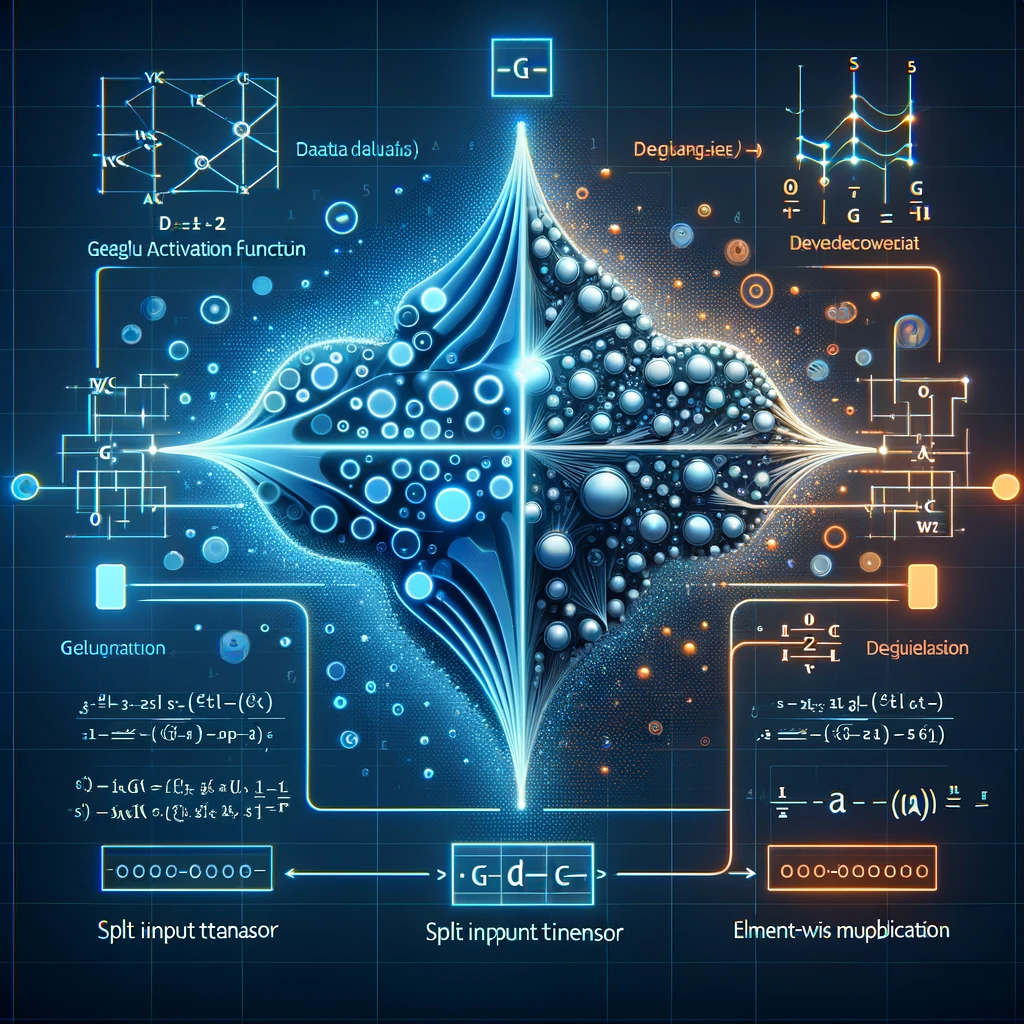Unlocking the Power of GeGLU: Advanced Activation Functions in Deep Learning
 Juan Carlos Olamendy
Juan Carlos Olamendy
Introduction
Activation functions are key pieces in the world of deep learning.
They introduce non-linearity into neural networks, enabling them to learn complex patterns and relationships in data.
Today, we're going to explore a specific activation function that's been making waves: GeGLU Activations.
GeGLU, or Gated Linear Unit with GELU activation, is a novel activation function that has shown promising results in deep learning models.
A variant of the Gated Linear Unit (GLU) and Generalized Linear Unit (GELU) activations, and designed to address some of their limitations.
Do you want to know more about what makes GeGLU activations so special?
Let's dive in and find out in this article.
Understanding GeGLU Activations
At its core, the GeGLU activation function is a sophisticated blend of innovation and mathematical precision. Defined by the formula GeGLU(x) = x sigmoid(x) + x 0.5 (1 + tanh[sqrt(2/pi) (x + 0.044715 x^3)]).
It marries the capabilities of GLU and GELU activations, offering a unique mechanism for controlling the flow of information through the network.
The development of GeGLU activations is rooted in the need for an activation function that can balance the trade-off between computational efficiency and model performance. The GeGLU activation function was developed as a more efficient alternative to GLU and GELU activations, offering improved performance in certain scenarios.
Compared to GLU and GELU activations, GeGLU activations have a more pronounced non-linear behavior, which can help neural networks learn more complex patterns. They also have a smoother gradient, which can improve the convergence speed during training.
For more information on GLU and GELU activations, check out the TensorFlow GELU documentation and the PyTorch GELU implementation.
Mathematical Properties and Advantages
The nonlinear nature of GeGLU activations introduces a level of flexibility unseen in linear activation functions. This non-linearity allows neural networks to model complex, non-linear relationships in data, which is crucial for many real-world applications.
This characteristic enables deep learning models to approximate virtually any function, embodying the Universal Approximation Theorem.
Another advantage of GeGLU activations is their continuous differentiability. This property is important for gradient-based optimization algorithms, which are the backbone of most deep learning training processes. The smooth gradient of GeGLU activations can help these algorithms converge faster and more reliably.
When juxtaposed with activation stalwarts like ReLU, GELU, Sigmoid, and Swish, GeGLU shines in its ability to balance range, nonlinearity, and training efficiency. This balance is crucial for the robust performance of neural networks across a plethora of tasks, from image recognition to language processing.
Applications and Performance
GeGLU activations have been successfully applied in a variety of deep learning models.
In areas such as computer vision and natural language processing, it has demonstrated a capacity to enhance model accuracy and speed, outperforming traditional activation functions in various benchmarks
In computer vision tasks, GeGLU activations can help convolutional neural networks (CNNs) learn more complex features. In natural language processing tasks, they can help recurrent neural networks (RNNs) and transformers model more complex language patterns.
When compared to other activation functions, GeGLU activations often outperform them in terms of model accuracy and training speed. However, the best activation function can vary depending on the specific task and dataset.
Implementing GeGLU in Deep Learning Models
Implementing GeGLU activations in deep learning models is straightforward.
Most popular deep learning frameworks, such as TensorFlow and PyTorch, provide built-in functions for common activation functions, including GeGLU.
Here's an example of how to implement GeGLU activations in TensorFlow and Keras:
import tensorflow as tf
def geglu(x, num_split=2, axis=-1):
"""
Implements the GeGLU activation function in TensorFlow/Keras.
Args:
x: Input tensor.
Returns:
A tensor, result of applying the GeGLU activation function.
"""
# Split input tensor along the last dimension
x, gate = tf.split(x, num_or_size_splits=num_split, axis=axis)
# Apply GELU to the gate
gate = tf.keras.activations.gelu(gate)
# Element-wise multiplication of x and gate
# x * gate
x = tf.multiply(x, gate)
return x
And here's how to do it in PyTorch:
import torch
import torch.nn.functional as F
def geglu(x, num_split=2):
"""
Implements the GeGLU activation function in PyTorch.
Args:
x: Input tensor.
Returns:
A tensor, result of applying the GeGLU activation function.
"""
# Split input tensor along the last dimension
x, gate = x.chunk(num_split, dim=-1)
# Apply GELU to the gate
gate = F.gelu(gate)
# Element-wise multiplication of x and gate
return x * gate
FAQs
Q: When should I use GeGLU activations?
A: GeGLU activations can be a good choice when you need an activation function that balances computational efficiency and model performance. They are particularly useful in tasks that require modeling complex, non-linear relationships in data.
Q: How do GeGLU activations compare to other activation functions?
A: Compared to other activation functions, GeGLU activations offer a unique balance of properties. They have a wider range than ReLU and Sigmoid, which can help prevent the vanishing gradient problem. They are also more computationally efficient than GELU and Swish.
Q: Do GeGLU activations impact model training and performance?
A: Yes, GeGLU activations can impact model training and performance. They can help neural networks learn more complex patterns, which can improve model accuracy. They also have a smoother gradient, which can speed up training times.
Conclusion
In conclusion, GeGLU activations are a powerful tool in the deep learning toolbox.
They offer a unique balance of properties that can help neural networks learn more complex patterns and improve model performance.
Looking to the future, we can expect to see more research and applications of GeGLU activations in deep learning. As datasets become larger and models become more complex, the need for efficient and effective activation functions will only grow.
External Links:
If you like this article, share it with others ♻️
Would help a lot ❤️
And feel free to follow me for articles more like this.
Subscribe to my newsletter
Read articles from Juan Carlos Olamendy directly inside your inbox. Subscribe to the newsletter, and don't miss out.
Written by

Juan Carlos Olamendy
Juan Carlos Olamendy
🤖 Talk about AI/ML · AI-preneur 🛠️ Build AI tools 🚀 Share my journey 𓀙 🔗 http://pixela.io